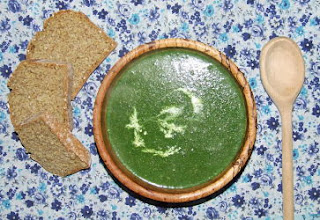
Put one bunch of well-washed watercress, one pint of stock, one clove of garlic, a pinch of nutmeg and half an ounce of flour into the liquidiser for thirty seconds. Bring to the boil in a pan and cook two to three minutes to thicken the soup. Season to taste. Decorate with a swirl of cream and serve.Recipes don't come much simpler than that - and it makes delicious soup!
 |
| Watercress Soup |
 |
| Sprouting watercress from a bag |
 |
| Forming roots |
 |
| Watercress? growing in Water Forlorns |